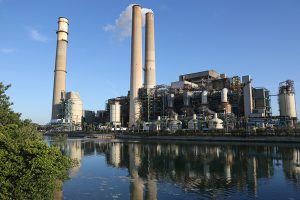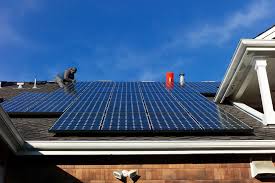[printfriendly] TECO has 600 megawatts of solar power either in place or planned. This array , with the Big Bend plant in the background, will provide 20 mg that will power about 3,300 homes. Photos courtesy TECO.
As discussions continue about the sources of nutrients fueling red tide and blue-green algae along Florida’s coastal waters, one critically important source continues blowing in the wind.
A 2013 study (the most recently completed) shows that nutrients from atmospheric deposition – stemming from power plants, automobiles and industry – can contribute up to half the nitrogen entering Tampa Bay.
“A primary reason why our region has been so successful in restoring seagrasses is that we’ve attacked all nitrogen sources leading to the Bay,” said Ed Sherwood, executive director of the Tampa Bay Estuary Program, which was one of the organizations involved in the 2013 study. “From the 1970s until now, the Nitrogen Management Consortium and TBEP partners have collectively reduced all nitrogen that enters the Bay by about 63%.”

A portion of those reductions can be attributed to prior upgrades at TECO and Duke Energy power plants that switched from coal to natural gas fuel sources, which reduces both nitrogen and carbon dioxide emissions. Those conversions, however, have come under fire recently, as TECO plans to switch one of its power plants at Big Bend to natural gas, with some environmental groups questioning the use of fracked natural gas.
“There’s no doubt that natural gas burns more efficiently than coal, but natural gas comes as natural gas – you don’t get to choose where it comes from,” said Byron Burrows, manager of air programs for TECO.
And using natural gas instead of coal is like driving a Prius hybrid vehicle instead of a large gasoline-powered car – you can go the same amount of miles with a lot less fossil fuel, he adds. “Yes, we will be using this plant more than our older plants, but we will be significantly reducing emissions – as well as the costs to customers.”

Tampa Electric is making some progress towards renewable energy, with major commitments to 600 megawatts of solar power either in place, being built or on the drawing board, powering more than 100,000 homes and removing an estimated 720,000 tons of carbon dioxide emissions annually.
As expected, many Apollo Beach residents would be pleased with additional conversions, although TECO points out that most of the smoke coming from the stacks is water, not ash. And some Apollo Beach residents did express fear that their waterfront homes would be impacted by sea level rise exacerbated by burning fossil fuel in the future.
Both the Sierra Club and the League of Women Voters strongly disapprove of the conversion, noting that the multi-million dollar conversion is expected to burn fossil fuel for at least 30 to 40 years.
For a region as vulnerable to sea level rise as Tampa Bay, the conversion to another type of fossil fuel is not a wise choice, they said. “The transition to renewable energy will be an economic boon, creating jobs and saving money, even as the financial burden of resiliency is falling on us most heavily,” writes Kent Bailey, chair of the Tampa Bay Sierra Club.
Two Hillsborough County commissioners – Pat Kemp and Mariella Smith – also spoke against the plant, as did St. Petersburg city council member Darden Rice.
But switching to renewable energy is, to date, not as reliable as fossil fuel, Burrows said. “It takes a lot of land to build a solar farm, neighbors don’t always support it in every location, and it needs to be near a major power line – extending energy grids for large uses can cost up to a million dollars a mile.”
The public hearing, before Administrative Law Judge Francine Ffolkes, will lead to a recommendation to the Florida Department of Environmental Protection on whether to approve or disapprove the project.
Solar to soon be more affordable for homeowners

One of the biggest stumbling blocks for Florida homeowners who wanted to install solar panels has been financing. Unlike California, where most solar-powered homes are using leased panels, it has been illegal in Florida where leasing companies would have been considered utilities.
That is changing, though. Earlier this month, the state Public Service Commission (PSC) determined that Tesla’s SolarLease product can be sold, effectively allowing customers who couldn’t easily spend or borrow an estimated $20,000 to lease the equipment with no money down. The PSC clearly stated that Tesla’s residential solar equipment lease (through Tesla’s SolarLease) does not constitute a sale of electricity.
It also noted that leasing the equipment to customers in Florida would not cause Tesla to be considered a public utility under state law and that the leases would not subject Tesla or its customers to regulation by the PSC.
The Tesla decision was the third in the last year by the PSC that determined a solar equipment lease is not considered to be a retail sale of electricity. Other companies to receive decisions in their favor have been Sunrun Inc. and Vivint Solar Developer Inc., and more are expected to follow.
